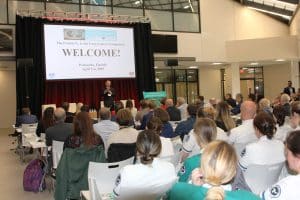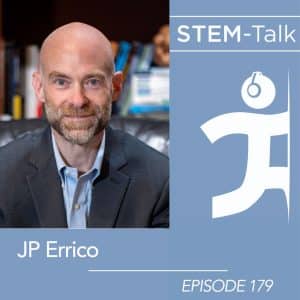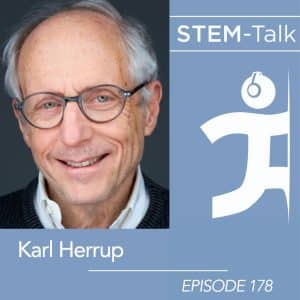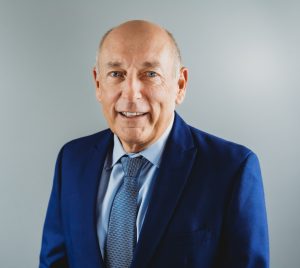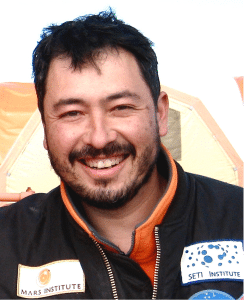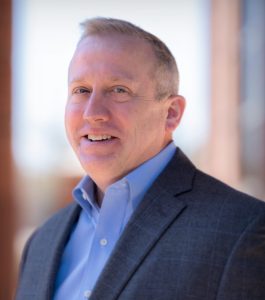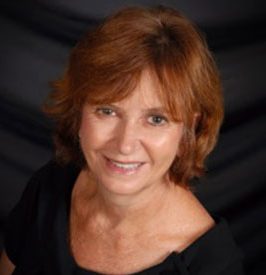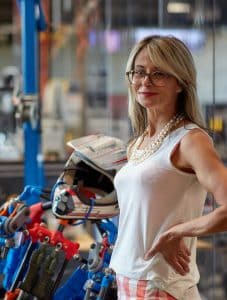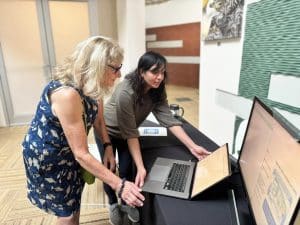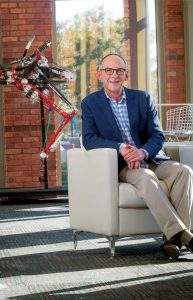STEM-Talk: Ken Forbus on AI and his development of the Structure Mapping Engine
Published 5.13.25
Episode 181 of STEM-Talk offers a meeting of some truly great minds in the field of artificial intelligence. It is available now on our website and wherever you listen to podcasts.
The conversation features three fellows of the American Association for Artificial Intelligence:
- Northwestern University’s Dr. Ken Forbus.
- IHMC founder Dr. Ken Ford.
- And retired associate director of IHMC Dr. James Allen.
Forbus is the Walter P. Murphy Professor of Computer Science and a Professor of Education at Northwestern University. He was the inaugural winner of the Herbet A. Simon Prize for Advances in Cognitive Systems.
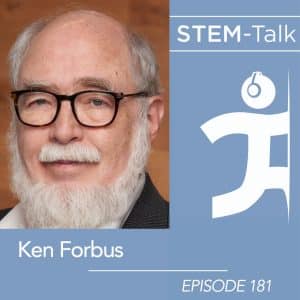 Co-hosts Ford and Allen interview Forbus about his development of the Structure Mapping Engine. In artificial intelligence and cognitive science, the Structure Mapping Engine is a computer simulation of analogy and similarity comparisons that helped pave the way for computers to think like humans.
Co-hosts Ford and Allen interview Forbus about his development of the Structure Mapping Engine. In artificial intelligence and cognitive science, the Structure Mapping Engine is a computer simulation of analogy and similarity comparisons that helped pave the way for computers to think like humans.
The conversation leads from Forbus’ early life in a family the raised and bred horses to his innovative work in a field he helped pioneer. The three AAAI fellows also have a fascinating discussion about the ethical guardrails that are needed as AI becomes more human-like.
One hint: It will require a lot more than simply meeting the Turing Test and declaring victory.
“The problem with the Turing Test is when it comes to interaction, we’re all like Fox Mulder (on the ‘X-Files’): We want to believe. We will believe anything. Simple string-based chatbots have been fooling people since the 1960s,” Forbus says.
As Ford notes, the media focus on chatbots has obscured other methods of AI that are used all of the time. It is as if, Ford notes, the broad public believes chatbots are all there is to AI, when, as this episode shows, that couldn’t be farther from the truth.
“There are so many other things going on that are not in the popular press,” Forbus says.
In this episode, listeners will learn about:
- The three revolutions that are going on in AI right now.
- How, Forbus as a self-described nerdy kid, grew up in a family that bred and raised horses. “The thing about calf-roping is, it’s a lot easier if the horse knows what it’s doing. Their job is to keep the rope taut so you can swing down and rope and quickly tie the calf. When you think about it, compare a horse to a self-driving car. A horse really works hard to not get itself and you killed. And if we have self-driving cars that worked more like horses, we’d be better off.”
- How AI intrigued him from an early age, and especially how he learned from the library at the University of Arizona’s collection of works written about AI — “two whole shelves” — in the early 1970s.
- The splash his 1984 paper on Qualitative Process Theory made on the world of AI. “We are surrounded by continuous phenomena. Things move, flow, heat up, cool down. Qualitative Process Theory, he says, creates a language for a kind of mental model to make predictions about the world, no numbers or equations needed.
- His collaboration with his wife Dr. Dedre Gentner on the Structure Mapping Engine project. This theory explains how people understand and reason about relationships between different situations, which is central to human cognition. It was foundational for the Structure Mapping Engine.
- How Structure Mapping Engine has changed and improved over time.
- His goal to create systems that can interact with people as apprentices or collaborators rather than just tools.
- Forbus’ book “Qualitative Representations: How People Reason and Learn About the Continuous World” which proposes that qualitative representations, which are symbolic representations that carve continuous phenomena into meaningful units, hold the key to one of the deepest mysteries of cognitive science and are central to human cognition.
IHMC is a not-for-profit research institute of the Florida University System where researchers pioneer science and technology aimed at leveraging and extending human capabilities. IHMC researchers and staff collaborate extensively with the government, industry and academia to help develop breakthrough technologies. IHMC research partners have included: DARPA, the National Science Foundation, NASA, Army, Navy, Air Force, National Institutes of Health, IBM, Microsoft, Honda, Boeing, Lockheed, and many others.
STEM-Talk: Pascal Lee on returning to the Moon — and heading to Mars
Published 4.9.25
Dr. Pascal Lee had led more than 30 expeditions to the Arctic and Antarctic to gain knowledge for a greater adventure — Mars.
Lee, a planetary scientist with the SETI Institute, the Mars I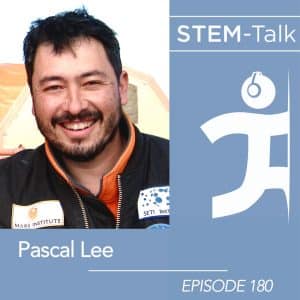 nstitute, and NASA Ames Research Center, brings his vision for reaching this next, lofty goal to his third appearance on STEM-Talk, available now wherever you listen to podcasts.
nstitute, and NASA Ames Research Center, brings his vision for reaching this next, lofty goal to his third appearance on STEM-Talk, available now wherever you listen to podcasts.
“The return to the moon is one of those things we would have expected to happen much sooner. And even the journey to Mars, I had always hoped that we’d be much farther along by now,” Lee says. “But this is feeling like it’s going to happen soon.”
Lee’s past appearances were Episode 121 in 2021 and Episode 17 in 2016. He also gave an Evening Lecture on our Pensacola campus in January 2025.
His research focuses on the history of ice and water on the Moon and Mars and the possibilities of exploring both of these worlds. Earlier this year, he and his student, Sourabh Shubham, announced the discovery of a previously unrecognized giant volcano on Mars, the Noctis Volcano.
“It’s not the largest volcano on Mars, it’s not the tallest volcano on Mars, but in contrast to all other volcanos that we know of, which are relatively well preserved, this one is so deeply eroded that not only do you see the outer lava layers and eruption layers, you also see the ancient ones that would have been buried inside the volcano,” Lee says.
While Mars exploration is more prevalent in recent popular imagination, Lee maintains that returning to the Moon and establishing a permanent base there is critical to the future of human space exploration.
“I see the moon as a scientific jewel,” he says. “There are so many things we can explore,” including caves on both the Moon and Mars, which could act as possible refuges for humans there. “You are protected from the ionizing radiation of space, you are subject to dampened temperature variations, protected from micrometeorites … Caves are the difference in something that is much more survivable for life from Earth versus the surface,” Lee says.
Lee has suggested setting up a lunar base at the floor of the Clavius crater. Clavius is where the moon base in the movie “2001: A Space Odyssey” was located, as well, Lee notes. “The fact that we could establish a base at Clavius and be on our way to fulfill the vision of ‘2001’ would be something very attractive to the public.” Beyond the cinematic and poetic importance, Lee says “Clavius has become the place to beat” as a lunar base homeport site.
The conversation also covers:
- What is appealing about exploring the Rutherford Crater caves near the Clavius crater. The caves “hold the promise of being cold enough to possibly have water-ice trapped in them. Being at Clavius gives us a nice opportunity without having to drive too far to explore a large number of caves on the moon which will pave the way for doing the same on Mars.”
- How contemporary interest in human space exploration appears tied to current geopolitical issues between the U.S. and China, much like the first space race between the US and USSR.
- The role nuclear power will play in the future of a lunar base.
- The prospects of colonizing Mars. “The life support system that a crew needs is essentially an intensive care unit. Why would you want to raise kids on Mars in an intensive care unit, in a place where they will never have a breath of fresh air, where they will not know the outdoors as we know the outdoors. I think some people who see Mars as this promised land are for some of them trying to escape the reality of the Earth, and that is not a good reason to go to Mars.”
- What makes the Martian moons Phobos and Demos so intriguing.
IHMC is a not-for-profit research institute of the Florida University System where researchers pioneer science and technology aimed at leveraging and extending human capabilities. IHMC researchers and staff collaborate extensively with the government, industry and academia to help develop breakthrough technologies. IHMC research partners have included: DARPA, the National Science Foundation, NASA, Army, Navy, Air Force, National Institutes of Health, IBM, Microsoft, Honda, Boeing, Lockheed, and many others.
Aging Symposium draws experts to IHMC
Published 4.4.25
Skeletal muscle is vital to human health and disease management, particularly as we age.
However, the muscle mass and functional declines that come with aging are influenced by a complex web of biological and behavioral factors.
On April 10 2025, the Florida Institute for Human and Machine Cognition (IHMC) will host experts across a host of disciplines for the “Skeletal Muscle in Aging, Healthspan, and Disease” symposium, organized by Dr. Marcas Bamman, Senior Research Scientist at IHMC and director of the Healthspan, Resilience and Performance research team.
“The symposium is an opportunity to discuss the state of knowledge on mechanisms and countermeasures, identify knowledge gaps, and we hope, chart a path toward high-impact research priorities,” Bamman said.
Online registration is still available here. Topics for discussion will include:
Hospital-Associated Disability, Dr. Cynthia Brown, Louisiana State University Health Sciences Center.
End of Life and Muscle Health: Proxies and Prognosis, Dr. Dan Sontheimer, Baptist Healthcare.
Research Priorities in Aging Skeletal Muscle & Healthspan, Dr. Amanda Boyce, Dr. Monica Serra, Dr. Lyndon Joseph, National Institutes of Health National Institute on Aging.
Age-Regulated Mechanisms Affecting Muscle Mass and Function, Dr. David Glass, Regeneron Pharmaceuticals.
Protein for Healthy Muscle Aging, Dr. Benjamin Miller, Oklahoma Medical Research Foundation & Oklahoma City Veterans Affairs Medical Center.
Epigenetic Mechanisms of Skeletal Muscle Aging, Dr. Payel Sen, NIH National Institute on Aging.
Tryptophan Metabolism: A Key Modulator of Functional Decline, Frailty and Aging, Dr. Reyhan Westbrook, Johns Hopkins University.
Cellular Senescence and Skeletal Muscle Aging, Dr. Nathan LeBrasseur, Mayo Clinic – Rochester.
The Aging Circadian Clock in Muscle: New Target for Therapeutics?, Dr. Karyn Esser, University of Florida.
MuRF1, E3 Ubiquitin Ligases & Regulation of Muscle Mass, Dr. Sue Bodine, Oklahoma Medical Research Foundation and Oklahoma City Veterans Affairs Medical Center.
Mitochondrial Involvement in Aging Skeletal Muscle, Dr. Russell Hepple, University of Florida.
Global Strategies to Improve Muscle, Cognitive, & Immune Function in Aging, Dr. Jamie Justice, XPRIZE Healthspan.
Resistance Training in Older Adults, Dr. Roger Fielding, Tufts University.
Elite Human Performance Across the Lifespan, Dr. Scott Trappe, Ball State University.
IHMC hosts Fredric G. Levin Lung Care Symposium March 27-28 in Pensacola
Published 3.17.25
The Fredric G. Levin Lung Care Symposium will bring to Pensacola experts in thoracic surgery, lung cancer research, and pulmonary care for a day of groundbreaking discussions and advancements in the field.
Hosted on the campus of the Florida Institute for Human and Machine Cognition (IHMC), this live virtual and in-person symposium serves as a platform for physicians, researchers, and healthcare professionals to explore the latest innovations in lung cancer treatment, surgical techniques, and patient care strategies.
“IHMC takes seriously our place as a home for innovation and scientific collaboration,” said Dr. Morley Stone, IHMC’s Chief Executive Officer. “Working with the team at Brigham and Women’s Hospital to host the Levin Lung Symposium is our honor.”
Established through the generosity of Pensacola native Fredric G. Levin, this symposium reflects his commitment to advancing medical research and improving patient outcomes. Levin was a highly regarded plaintiff’s attorney with a national reputation whose career spanned more than 40 years. He died in 2021 of COVID after having survived stage 4 lung and brain cancer.
Sessions will feature renowned faculty, emerging research, and multidisciplinary collaboration to drive progress in thoracic surgery and lung health.
As a leader in lung cancer treatment and thoracic surgery, the Brigham and Women’s Hospital Division of Thoracic Surgery is honored to host this event, reinforcing its mission to deliver cutting-edge care and transformative research.
The symposium is a unique resource for physicians, nurses, advanced practice providers, researchers, trainees, and medical students. Agenda highlights include:
- Surgical Innovation: Unveiling the latest techniques and breakthroughs in lung cancer surgery.
- Lung Cancer Diagnosis and Screening: Exploring innovative methods for early detection.
- Resources for Lung Cancer Screening: Equipping you with the essential tools for effective screening.
- Lung Cancer Screening Programs: A deep dive into program development and best practices.
- The Importance of Multidisciplinary Collaboration: Fostering teamwork for comprehensive patient care.
- Challenges in Coordinating Multidisciplinary Care: Navigating the complexities of collaboration.
- Clinical Pathways and Collaboration: Streamlining patient journeys for optimal outcomes.
- Palliative Care: Enhancing the quality of life for lung cancer patients.
- Medical Risk and Error: Strategies for minimizing risk and maximizing patient safety.
The registration link is here: https://cmecatalog.hms.harvard.edu/fredric-g-levin-lung-cancer-symposium . Use the discount code FGLLCSMEDSTU25 at checkout for a $25 registration fee.
IHMC is a not-for-profit research institute of the Florida University System where researchers pioneer science and technology aimed at leveraging and extending human capabilities. IHMC researchers and staff collaborate extensively with the government, industry and academia to help develop breakthrough technologies. IHMC research partners have included: DARPA, the National Science Foundation, NASA, Army, Navy, Air Force, National Institutes of Health, IBM, Microsoft, Honda, Boeing, Lockheed, and many others.
Humanoid robotics and exoskeletons lead latest IHMC newsletter
Published 3.14.25
When Jared Li was job-hunting in late 2020, he had never heard of the Florida Institute for Human and Machine Cognition (IHMC).
He was helping his parents in West Lafayette, Ind., move when he looked into IHMC at the recommendation of colleagues from his alma mater, the Georgia Institute of Technology. Then he saw a 2015 video of the DARPA Robotics Challenge, an international competition in which the IHMC robotics team placed second.
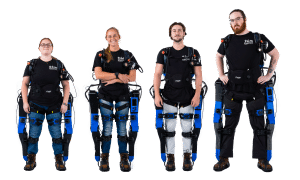 It seemed familiar, Li says, and then he remembered watching it in real time as a young undergraduate.
It seemed familiar, Li says, and then he remembered watching it in real time as a young undergraduate.
“I remember just being like, oh, so this is that place,” Li says. “I got really excited about the opportunity.”
He joined IHMC in April 2021 and since has served as project manager and lead engineer on multiple exoskeletons. Li was wearing the Eva exoskeleton in December 2024 for its first out-of-lab field test. You can watch the test run here.
“The ability to wear it yourself, take it out into the world, and understand what the end user is going to feel is tremendously helpful for future development,” Li says.
Eva is a project funded by the U.S. Department of Energy in collaboration with Georgia Tech and Sandia National Laboratories. The out-of-lab excursion was a critical milestone for the project because it demonstrates the ability of the device to operate outside of controlled environments. In March of 2025, Li and the team presented at the Department of Energy’s Waste Management Symposium.
The Eva collaboration aims to help address the healthspan issues of a specialized, aging workforce, but there potentially are a host of other applications for the work.
“There are still so many barriers to cross,” Li says. “Eventually we could expand the upper body to add attachments to be able to completely cover the whole body and to do very complex, very difficult tasks.”
You can read more about Eva in the latest edition of IHMC’s Newsletter, which is now live. Visit our website to have the newsletter delivered to your inbox.
IHMC is a not-for-profit research institute of the Florida University System where researchers pioneer science and technology aimed at leveraging and extending human capabilities. IHMC researchers and staff collaborate extensively with the government, industry and academia to help develop breakthrough technologies. IHMC research partners have included: DARPA, the National Science Foundation, NASA, Army, Navy, Air Force, National Institutes of Health, IBM, Microsoft, Honda, Boeing, Lockheed, and many others.
Celebrate Robotics Week at IHMC Open House on April 11, 2025
Published 3.13.25
Want to meet the human who battles the humanoid robot Nadia at ping pong and boxing?
Or the researchers harnessing virtual reality and data visualization to help improve our ability to manage, synthesize, and act upon data in a slew of disciplines — from search and rescue and special warfare operations to the early detection of mild traumatic brain injuries and more.
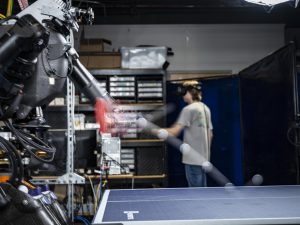
IHMC Researchers utilize the Nadia robotic platform to develop and optimize various control strategies and autonomous behaviors. Photo Credit IHMC © all rights reserved
The Florida Institute for Human and Machine Cognition is where you want to be on April 11, 2025.
That’s the day that dozens of researchers, roboticists, engineers, cognitive scientists, and human performance experts will share what they love about their life in science during Open House for National Robotics Week.
From 4 to 7 p.m., IHMC staff will welcome families, students, and the public for tours, walk-throughs, and inspiration on the Pensacola campus on South Alcaniz Street. The final tour begins at 6:30 p.m.
The family-friendly event encourages scientific discovery through hands-on activities, challenges, and demonstrations while providing the opportunity to learn. Visitors will meet IHMC researchers and see first-hand their work in drones, robotics, virtual reality experiences, human performance research projects, data visualization, and more.
National Robotics Week was established by Congress in 2010 and aims to bring together students, educators, and influencers who share a passion for robots and technology.
Open House is a way for researchers like Jared Li, who wore the Eva exoskeleton on its first out-of-lab test, to share the love and enthusiasm for what they do with others. And possibly recruit a future colleague or two to the cause.
“IHMC is the best of all possible worlds as a researcher. You can do industry-style robotics research, but you also get the ability to do really cool new things that academia could also provide.
“Every day is great here, even though the research is hard, and the work can get difficult. A lot of the times you never have a good answer for the problems you’re trying to solve. It still is — daily — very satisfying to me.”
IHMC is a not-for-profit research institute of the Florida University System where researchers pioneer science and technology aimed at leveraging and extending human capabilities. IHMC researchers and staff collaborate extensively with the government, industry and academia to help develop breakthrough technologies. IHMC research partners have included: DARPA, the National Science Foundation, NASA, Army, Navy, Air Force, National Institutes of Health, IBM, Microsoft, Honda, Boeing, Lockheed, and many others.
Registration open for 2025 Summer Robotics Camp
Published 3.7.25
Students learn a lot at Summer Robotics Camps at the Florida Institute for Human and Machine Cognition. But some of the most meaningful lessons aren’t limited to programming.
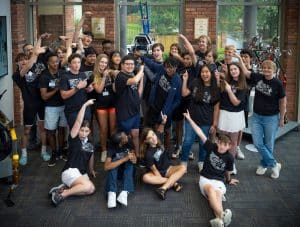
IHMC Summer Robotics Camp is a week long program designed to expose young minds to the wonders of the human-centered research conducted at IHMC. Photo Credit IHMC © all rights reserved
Aryn Stinnett is a student at King Middle School who participated in camp in 2024. Her experience inspired her to consider a career that might meld her interest in agricultural science and robotics.
“I would tell kids, just go for it. It’s really interactive, it’s very hands on, and you get to explore different things. Maybe you explore something you didn’t know a lot about and you learn, like I did, that you want to work in the field. Whatever you’re thinking about robotics, give it a shot. You might end up loving it like I do.”
Now is the chance for students like Aryn to register for the 2025 season of Robotics Camp in Pensacola. Registration for camp in Ocala opens March 17.
Students don’t need prior experience in programming or prior knowledge about robots to enjoy this camp, said Dr. Ursula Schwuttke, director of educational outreach for IHMC’s Pensacola and Ocala campuses. “There’s no better way to introduce these STEM concepts to your child.”
Amaya Harper is a sophomore at Gulf Breeze High School who attended last summer and definitely recommends it to other students. “I was worried at first that we would have to have some kind of background on it, but the program is really easy to ease into.”
Seren Tillery is an eighth grader at Creative Learning Academy said she learned a lot from robotics camp. “I brought it into my actual science curriculum where we have done some of the things from robotics camp and it has given me a leg up.”
Rising eighth graders should register for the week of June 2-5; rising ninth and 10th graders should register for the week of June 9-12.
Participants will spend four days learning to program LEGO Mindstorms robots, meeting STEM professionals and learning about robotics research at IHMC. No prior experience is necessary. Priority will be given to students who haven’t attended in the past.
Past camper Ben Fluharty, now a junior at Pace High School, was a camp volunteer last summer, assisting the instructor, helping younger students, and earning community service credit for his hours. “It’s fun and you’re developing the skills to work with people. You’re also opening your mind to stem careers.”
Camp is sponsored by the NextEra Foundation, Florida Blue and Cox. Their support helps make these camps possible and funds scholarships to cover camp fees for students from families of limited means.
Isabella Nickinson, now a freshman at West Florida High School, attended camp as a Workman Middle School student. Attending camp in the transition year between middle and high school was valuable, she said.
“I met a bunch of people I would be going to high school with, which was cool,” she said. “I liked how they have a different range of scientists, so it shows that different kinds of people can be a scientist. I would say to parents, ‘Send your kids. The worst thing that happens is that they don’t like it. The best thing that happens is that your kid will say, ‘This is cool. I can do this.’”
IHMC is a not-for-profit research institute of the Florida University System where researchers pioneer science and technology aimed at leveraging and extending human capabilities. IHMC researchers and staff collaborate extensively with the government, industry and academia to help develop breakthrough technologies. IHMC research partners have included: DARPA, the National Science Foundation, NASA, Army, Navy, Air Force, National Institutes of Health, IBM, Microsoft, Honda, Boeing, Lockheed, and many others.
STEM-Talk: JP Errico on vagus-nerve stimulation, inflammation and chronic disease management
Published 3.5.25
STEM-Talk episode 179, featuring JP Errico, the author of “The Vagus Immune Connection: Harness Your Vagus Nerve to Manage Stress, Prevent Immune Dysregulation and Avoid Chronic Disease,” is now available.
Errico is known for his innovative work in neuroimmunology, the study of how the nervous system and immune system interact, with a focus on transcutaneous vagus nerve stimulation. He recently joined IHMC as a Senior Research Scientist.
An early breakthrough in his career came in work studying the link between vagus-nerve stimulation and asthma. He says that patients admitted to the hospital for asthma — which numbers in the hundreds of thousands annually — spend more time in the hospital than patients who undergo a full spinal fusion surgery.
Errico and his colleagues tried stimulating the vagus nerve during asthma attacks on patients who were not responding to other treatments.
“They’d be hunched over, struggling to breathe and all of the sudden, at one point, they would suddenly just sit back and be able to breathe normally. And they would look at you with wide eyes and say, ‘What did you do?!’
They stimulated the vagus nerve.
Errico is an accomplished scientist, executive, entrepreneur, and inventor. He is the founder of ElectroCore, a prominent company specializing in neuromodulation that has developed a pioneering noninvasive vagus nerve stimulator.
On STEM-Talk, he shares that journey with IHMC’s Founder Dr. Ken Ford and co-host Dr. Tim Broderick, IHMC’s Chief Science officer.
Neuroimmunology affects a wide range of health factors including inflammation, mental health and aging. Errico believes everyone should understand neuroimmunology to live a healthy life.
“I’ve come to realize that stimulating the nervous system the right way also activates multiple other systems in the body,” Errico says. “One is your immune system. The other is your cellular metabolism. It also has a pretty profound effect on your microbiome. When I think of the four most fundamental pillars on which all life functions, it’s your immune system, it’s your cellular metabolism it’s your microbiome and it’s your autonomic nervous system.”
He earned an undergraduate degree in aeronautical engineering from MIT and worked at the U.S. Air Force’s national laboratory, Lincoln Laboratories. He also holds graduate degrees in both law and mechanical/materials engineering from Duke University.
The conversation covers a lot of ground including:
- The influence on his life and career of teachers in his high school life that encouraged this math whiz to squeeze in years of advanced level math instruction at a young age.
- The inspiration he found in Robert Jastrow’s “Red Giants and White Dwarfs,” a book he has shared now with his own daughter, and “Black Holes, White Dwarfs, and Neutron Stars” by Saul Teukolsky and Stuart Shapiro.
- How his uncle’s frustrating experience with the design of medical devices fueled his interest in that field.
- What he views as the confluence of law, science, and math. “The law is supposed to be about the truth, but at the end of the day, there is only one truth and that truth is math. Science is a story that we tell to try and explain what we observe, and that story evolves over time. It’s always imperfect, but math is perfect. Math is the truth.”
- How the search for maximizing the efficacy of non-invasive vagus nerve stimulation led to gammaCore and Truvaga, devices his company has designed.
- The role that the vagus nerve plays in the treatment of pain, phantom pain, depression, ketone expression, improving learning.
- Errico’s book, “The Vagus Immune Connection: Harness Your Vagus Nerve to Manage Stress, Prevent Immune Dysregulation and Avoid Chronic Disease,” and much, much more.
Listen to our conversation with Errico, and browse the full STEM-Talk library, wherever you enjoy podcasts.
IHMC is a not-for-profit research institute of the Florida University System where researchers pioneer science and technology aimed at leveraging and extending human capabilities. IHMC researchers and staff collaborate extensively with the government, industry and academia to help develop breakthrough technologies. IHMC research partners have included: DARPA, the National Science Foundation, NASA, Army, Navy, Air Force, National Institutes of Health, IBM, Microsoft, Honda, Boeing, Lockheed, and many others.
STEM-Talk: Karl Herrup on shortcomings of Alzheimer’s research
Published 2.6.25
After more than a century of research, the underlying cause of Alzheimer’s remains a mystery. Dr. Karl Herrup has made a career of trying to unravel that mystery.
For decades, the leading theory has been that abnormal amyloid plaques in the brain are the central cause of the disease.
On this episode of STEM-Talk — available now — Herrup shares his view that the amyloid cascade hypothesis is not only flawed but also could be holding back research for a cure.
“At root, the problem stems from trying to make a complicated disease simple,” Herrup says. “At a more practical level, the problem goes back to the very first description of the disease itself by the guy whose name is on the disease.”
The history of assumptions made about the disease, and the impacts those assumptions have had since is just one aspect of this fascinating conversation.
Herrup is a professor of neurobiology and an investigator in the Alzheimer’s Disease Research Center at the University of Pittsburgh School of Medicine. He is also the author of How Not to Study a Disease: The Story of Alzheimer’s.
In this episode we learn:
- How investment in science enrichment education in the wake of the launch of Sputnik influenced Herrup as a child growing up in Pittsburgh, Pa.
- How a series of “happy accidents” fueled his career including studying neuroscience at Stanford University, studying developmental neurogenetics, and pursuing a secondary post-doctoral degree in Switzerland, working at Yale, spending several years at a university in Hong Kong, and ultimately returning to his hometown to start the lab he currently runs.
- How his interactions with Alzheimer’s researchers, led him to see similarities in these diseases of aging and the developmental disorders he was already studying.
- The differences between Alzheimer’s and dementia broadly and clinically.
- The failures of the amyloid cascade hypothesis in three basic tests, and an alternative hypothesis Herrup proffers.
- The emergent nature of the brain and the potential for this emergence to help explain Alzheimer’s disease.
- The fact that there is no solution to the problem of dementia that does not rely on an understanding of the aging process.
- A series of studies that Herrup conducted on the benefits of exposure to Japanese gardens on the clinical symptoms of Alzheimer’s and much more.
“I don’t know that I would recommend my life trajectory to anyone, but I would recommend the willingness to be open to new ideas and to change,” Herrup says. “It’s scary, but the one thing I’m most proud about is that I would squelch that fear and look at the opportunity.”
Listen to STEM-Talk wherever you enjoy podcasts.
IHMC is a not-for-profit research institute of the Florida University System where researchers pioneer science and technology aimed at leveraging and extending human capabilities. IHMC researchers and staff collaborate extensively with the government, industry and academia to help develop breakthrough technologies. IHMC research partners have included: DARPA, the National Science Foundation, NASA, Army, Navy, Air Force, National Institutes of Health, IBM, Microsoft, Honda, Boeing, Lockheed, and many others.
Pensacola attorney joins IHMC Board of Directors
Published 1.29.25
Pensacola attorney H. Wesley “Wes” Reeder has joined the Board of Directors for the Florida Institute for Human and Machine Cognition (IHMC).
Reeder is president and shareholder for Emmanuel Sheppard & Condon. Dr. Morley Stone, IHMC’s chief executive officer, said Reeder’s expertise and experience will be a great asset in continuing to move the Institute forward.
“IHMC is very fortunate to have Wes join our board of directors,” Stone says. “His personal and professional experience — from his U.S. Navy service to his legal career — will be an incredibly valuable resource for us. We all look forward to working with Wes as we move into the next chapter of IHMC’s story.”
Reeder says he has long admired IHMC and its work from afar.
“As a retired service member, I have always been interested in the work IHMC does in support of our military’s mission, both on a broad operational scale and in relation to research and development,” Reeder says. “Personally, just being able to associate and work with all the talented individuals at IHMC is very exciting.”
Reeder is Board Certified by the Florida Bar Association in Construction Law and has extensive experience in construction and commercial litigation. As a Florida Supreme Court Certified Circuit Civil Mediator, he serves clients statewide with an emphasis on the Panhandle and North Florida, handling a variety of issues including construction defects, contract disputes and related litigation.
Prior to his law career, Reeder served more than 24 years as a Naval Reserve Officer. While on active duty in the U.S. Navy, he served as a crewman with the Naval Flight Demonstration Squadron — also known as the Blue Angels.
Community service is important to Reeder, as can be seen by his involvement and leadership in several local and regional associations including the Naval Reserve Officer Association, Greater Pensacola Chamber of Commerce, Gulf Breeze Rotary Club, Pensacola Heritage Foundation, Blue Angels Alumni Association, Pensacola Runners Association, Fiesta of Five Flags, and Pensacola Navy Days.
IHMC is a not-for-profit research institute of the Florida University System where researchers pioneer science and technology aimed at leveraging and extending human capabilities. IHMC researchers and staff collaborate extensively with the government, industry and academia to help develop breakthrough technologies. IHMC research partners have included: DARPA, the National Science Foundation, NASA, Army, Navy, Air Force, National Institutes of Health, IBM, Microsoft, Honda, Boeing, Lockheed, and many others.
Join a clinical trial to uncover the health benefits of exercise in older adults
Published 1.23.25
Florida Institute for Human and Machine Cognition (IHMC) is recruiting people 60 years and older for a seven-month trial to better understand the health benefits of exercise. Results of the trial are aimed toward personalizing exercise prescription to maximize the health benefits attained for each older adult.
This clinical trial — supported by a National Institutes of Health award to Dr. Marcas Bamman — is a collaboration among IHMC, the Oklahoma Medical Research Foundation and the University of Florida. Recruitment of 250 participants is under way in both Pensacola and Oklahoma City. Learn more and complete the prescreening process here.
It is precisely the kind of project that IHMC’s new 40,000 square foot Healthspan, Resilience, and Performance Research Complex was designed to support, says Bamman, the Principal Investigator and Senior Research Scientist who leads that team.
“Exercise is a potent treatment with the promise to mitigate most aging hallmarks, but there is substantial variability in individual exercise responsiveness,” Bamman says. “We believe this trial will help us learn more about why that variability occurs, along with strategies to boost responsiveness.”
The trial is called Multidimensional Modeling to Maximize Adaptations to Exercise (M3AX). This individual response variability was first identified in the context of endurance training and later was established with resistance training by current members of the IHMC team nearly 20 years ago. M3AX is the chance to build upon that finding to learn more.
Age-related functional declines are thought to be caused by biological processes that ultimately compromise healthspan and quality of life. Low cardiorespiratory fitness and low functional muscle quality are both manifestations of the deterioration in the cellular hallmarks of aging. And both metrics can be modified with endurance and resistance training.
M3AX will test the hypothesis that factors central to aging itself – protein metabolism, cellular energetics, inflammation and circadian rhythms — are contributors to what determines whether someone experiences clinically important improvements in cardiorespiratory fitness and functional muscle quality through exercise training.
Senior Research Associate Craig Tuggle will manage the project.
Key to the success of the trial will be the recruitment of 250 people willing to commit to a highly structured 23-week exercise training regimen.
“It is a big commitment we are asking of participants but based on past experience with clinical trials in this age group, we think they will enjoy participating,” Tuggle says.
In addition to the exercise training 3 times per week, participants will undergo several clinical and performance assessments, learning more about themselves while contributing to scientific discovery.
“The trial is an exciting opportunity to advance science while further exploring the many health benefits of exercise training,” Bamman says.
IHMC is a not-for-profit research institute of the Florida University System where researchers pioneer science and technology aimed at leveraging and extending human capabilities. IHMC researchers and staff collaborate extensively with the government, industry and academia to help develop breakthrough technologies. IHMC research partners have included: DARPA, the National Science Foundation, NASA, Army, Navy, Air Force, National Institutes of Health, IBM, Microsoft, Honda, Boeing, Lockheed, and many others.
STEM-Talk: Frank Butler on revolutionizing combat casualty care
Published 1.16.25
Frank Butler has saved the lives of countless U.S. military servicemembers due in large part to something he saw as a college sophomore.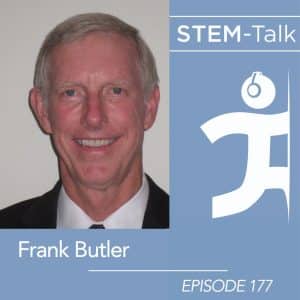
As a Georgia Institute of Technology student on a Navy ROTC scholarship, Butler was in Virginia in 1969 learning about different aspects of Navy careers.
A helicopter full of Navy SEALs flew over the group of students that included Butler. They dropped from that helicopter over water and staged a demonstration of using explosives to clear a beach for an amphibious assault, “just as they had done in World War II,” he says.
“I was pretty much sold from the moment I saw that demonstration and determined that going into the SEAL teams was what I wanted to do,” Butler says.
It may have delayed his entry into medicine, but these twin tracks would lead Butler down a path that ultimately changed the way battlefield medicine is conducted.
It’s just part of the journey he shares with listeners on Episode 177 of STEM-Talk, available now wherever you listen to podcasts.
An ophthalmologist and a retired Navy Undersea Medical Officer, Butler served as a SEAL platoon commander before he went to medical school.
On Jan. 2, 2025, Butler received the Presidential Citizens Medal from President Joe Biden for introducing Tactical Combat Casualty Care in 1996 to battlefield trauma care, setting new standards for tourniquet use for injuries in war — and ultimately in civilian life.
TCCC is an innovation that revolutionized pre-hospital battlefield trauma care, a field he says had remained largely unchanged for nearly 130 years after the Civil War.
“(That lack of innovation) was a stunning thing to realize,” Butler says.
Even though Butler’s paper on TCCC was published in 1996 in the Journal of Military Medicine, it took time for it to become protocol across the entire military community. In April 1997, Rear Admiral Tom Richards, commander of the Naval Special Warfare Command and leader of the SEAL community, signed a directive mandating TC3 as the standard for battlefield trauma care.
The 75th Ranger Regiment and Delta Force (the U.S. Army’s 1st Special Forces Operational Detachment-Delta) followed shortly afterward, Butler says.
Still, it took more than five years — and the war in Afghanistan following the Sept. 11, 2001, terrorist attacks —for TCCC to become a widely used as a standard of care.
“There were scattered units when 9/11 happened who had TCCC on board, but the vast majority had no idea what TCCC stood for,” Butler says.
They learned — and have saved countless lives since. The conversation includes:
- Butler’s childhood as part of a big Catholic family growing up in Savannah, Ga., playing pickup basketball and reading books from the public library.
- His experience in Basic Underwater Demolition SEALs School, and his transition to Jacksonville Naval Hospital, and the Navy experimental dive unit.
- How he transitioned to medical school, his internship in family medicine, and how he chose ophthalmology as a specialty.
- Projects he worked on as research director for the SEALs, including battlefield trauma care, a tactical athlete program, improved treatment of decompression sickness, and the SEAL nutrition guide, the tactical athlete program.
- His book, “Tell Them Yourself: It’s Not Your Day to Die,” and the 1993 “Black Hawk Down” incident in Mogadishu, Somalia, plus much more.
IHMC is a not-for-profit research institute of the Florida University System where researchers pioneer science and technology aimed at leveraging and extending human capabilities. IHMC researchers and staff collaborate extensively with the government, industry and academia to help develop breakthrough technologies. IHMC research partners have included: DARPA, the National Science Foundation, NASA, Army, Navy, Air Force, National Institutes of Health, IBM, Microsoft, Honda, Boeing, Lockheed, and many others.
Three researchers awarded at The Takeoff: Northwest Florida Pitch Day
Published 1.23.25
Cultivating innovation is in the DNA of the Florida Institute for Human and Machine Cognition.
The Takeoff: 2024 Northwest Florida Pitch Day was another opportunity for the partnership between IHMC and Space Florida to yield fruitful results in the name of innovation.
Three IHMC Research Projects were featured at The Takeoff, a forum for regional startups and researchers to share their stories in front of venture capital and investment firms.
Dr. Morley Stone, IHMC’s Chief Executive Officer, said The Takeoff “showcased IHMC’s growing commercialization interests and Florida’s prominence as a hub for cutting-edge technology, investment, and entrepreneurship, reinforcing the region’s critical role in shaping the future of innovation.”
IHMC Presenters were awarded $5,000 each for the following projects:
Tactile Glove Technology: Senior Research Scientist Dr. Jeff Phillips’ project for the U.S. Air Force School of Aerospace Medicine that aims to create haptic gloves with a tactile selector embedded to improve dexterity and performance of in-flight tasks. The patented selector improves haptic feedback and precise digital manipulation of touch screens and other controls while wearing gloves.
Airborne and Portable Electromagnetic Sensing. Senior Research Associate Andy Bellina shared a project to design a low Size, Weight, Power, and Cost (SWaP-C) Electromagnetic Radiation (EM) detector/receiver that is light enough to be deployed on a small Unmanned Aircraft System, but adaptable enough to be used as a wearable.
KENNEL Threat Detection System. Senior Research Associate Daniel Duran highlighted a threat detection system that could provide a lower-cost initial line of perimeter defense for critical infrastructure and military personnel. These networked sensors can track light, temperature, motion, chemical, biological, radiological, nuclear, and explosive exposures.
Private sector presenters that earned awards were:
ATOR Labs, $20,000: ATOR is a Panama City-based company focused on respiratory protective device testing. ATOR showcased Omnicheck, a testing device for respiratory protective devices to ensure employee safety across industries such as firefighting, oil and gas, chemical, and nuclear, and Automated Breathing Metabolic Simulator, used as a foundation for device testing.
RSAE Labs, $7,500: RSAE is a Lynn Haven-based company that is disrupting the global logistics industry. The company is innovating in the Internet of Things (IoT) landscape with a proprietary protocol technology.
Piersica, $7,500: Piersica is a Tallahassee-based company leading energy storage innovation with next-generation solid-state batteries. The company has a solid-state separator with higher conductivity than conventional separators and a new lithium metal anode structure that improves upon current anode technology.
In addition to IHMC and Space Florida, the state entity that promotes aerospace and space-related business development, financing, research and development, event sponsors were TechFarms Capital and Saltmarsh, Cleaveland & Gund.
“Through strategic programs like The Takeoff that bring together industry leaders, investors, and government, Space Florida and our partners are driving the commercialization of cutting-edge research and positioning the region as a node in the network of technology research and development,” said Rob Long, president and CEO, Space Florida.
Kelly Reeser, General Partner, TechFarms Capital, said the event was key to mobilizing investment capital in Northwest Florida.
“The dynamic exchange between investors and founders/technologists was palpable, and we’re excited about the positive impact this will have on our collective future,” Reeser said.
IHMC is a not-for-profit research institute of the Florida University System where researchers pioneer science and technology aimed at leveraging and extending human capabilities. IHMC researchers and staff collaborate extensively with the government, industry and academia to help develop breakthrough technologies. IHMC research partners have included: DARPA, the National Science Foundation, NASA, Army, Navy, Air Force, National Institutes of Health, IBM, Microsoft, Honda, Boeing, Lockheed, and many others.
Dr. Pascal Lee kicks off 2025 Evening Lectures in Pensacola
Published 1.10.25
Dr. Pascal Lee had led more than 30 expeditions to the Arctic and Antarctic to gain knowledge that might be helpful for a greater adventure — Mars.
Lee, a planetary scientist with the SETI Institute, the Mars Institute, and NASA Ames Research Center, brings his vision for reaching this next, lofty goal to the first Evening Lecture of 2025 hosted by the Florida Institute for Human and Machine Cognition.
His talk, “Moon to Mars: Our Amazing Human Exploration Future Ahead,” begins at 6 p.m. on Jan. 30 in the Institute’s classroom at 40 S. Alcaniz St., in downtown Pensacola.
Lee’s research focuses on the history of ice and water on the Moon and Mars and the possibilities of exploring both of these worlds. Earlier this year, he and his student, Sourabh Shubham, announced the discovery of a previously unrecognized giant volcano on Mars, the Noctis Volcano.
Returning to the Moon and venturing on to Mars will be humanity’s greatest endeavors in space this century, Lee says. Each destination offers amazing places to explore, profound science to conduct, potential resources to assess, a permanent human presence to establish, and a great future to imagine, plan and create.
His talk examines current plans to return to the Moon and journey on to Mars, the challenges this presents, the wonders that lie ahead, and the choices needed to make this possible.
He wintered-over for 402 days at the French Antarctic base, Dumont d’Urville, and also led the Northwest Passage Drive Expedition – a record-setting vehicular drive across the Arctic along the fabled Northwest Passage, which is the subject of the documentary “Passage to Mars.”
Lee is a member of the U.S. National Academies’ steering committee on “A Science Strategy for the Human Exploration of Mars.” He is a recipient of the U.S. Antarctica Service Medal, the National Space Society Space Pioneer Award for Science and Engineering, the Space Frontier Foundation’s Vision to Reality Award, and the Sagan Prize for the Popularization of Science.
The Premier Sponsor of the Lecture Series is The Bear Family Foundation. Season Sponsors are The Orth Family, Clark Partington, and Joanne Bujnoski and Martin Kandes. Lecture Sponsors are Dr. Ed and Judy Galbavy: Carousel House and Dry Farm Wines.
Registration for this and every Evening Lecture is free. Upcoming Pensacola lectures include:
Feb 13: Dr. Tim Broderick, “Wearable Devices That Extend Human Health, Performance, and Teaming.”
March 4: Michael Larson.
April 24: Dr. Dave Rabin, “The Art and Neuroscience of Self-Healing and Learning.”
May 22: Lilianne Mujica-Parodi, Director of the Laboratory for Computational Neurodiagnostics at Stony Brook University.
Visit https://www.ihmc.us/life/evening_lectures/pensacola-lecture-series/ for the latest schedule of Evening Lectures.
Science Saturdays return for 2025 with new hands-on learning opportunities
Published 1.8.25
Science Saturdays are back and ready to heat up young scientific minds in 2025.
These 90-minute educational enrichment sessions are a cornerstone of community outreach at Florida Institute for Human and Machine Cognition (IHMC). Topics for the 2025 season include photo editing, roller coasters, human performance, and more. The sessions are aimed at students in grades 3-7 and are free to attend thanks to the support of community partners.
In the series’ 16 years, nearly 5,600 students have attended and explored their interest in a wide array of science and technology topics, according to Dr. Ursula Schwuttke, director of educational outreach for IHMC.
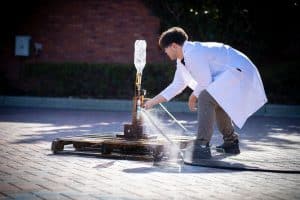
IHMC Research Scientist Jared Li taught Science Saturdays attendees the fundamentals of rocket engineering. Photo Credit IHMC © all rights reserved
“Students who become interested in science when they are young are more likely to be ready to pursue those subjects in high school and college,” Schwuttke said. “Our sponsors have helped us establish Science Saturdays as a place for students to explore a wide array of scientific subjects independent of family resources.”
Surveys conducted with families consistently show that the sessions are a lot of fun, and the variety of topics is intended to offer something that interests everyone, Schwuttke says.
“We consider those factors to be a good measure of the quality of our effort,” she says. “Enjoyment of science by young students is important for developing the long-term interest that Science Saturdays are designed to foster.”
Sponsors for the 2023-2024 series in Pensacola include Premier Sponsor NextEra Energy Foundation/Florida Power & Light and Sponsors Florida Blue Foundation, the Escambia County Sheriff’s Office (with Law Enforcement Trust Fund monies), and Cox.
SCIENCE SATURDAY SPRING SCHEDULE
The schedule for Science Saturday for the Spring is complete. Use this link to stay up to date on dates and topics for these sessions. And share the link with friends with children in grades 3-7 https://www.ihmc.us/life/science_saturdays/
Pensacola Sessions
Jan. 25: William Howell, Photo Editing.
Feb. 22: Dr. Matt Johnson, Roller Coasters.
March 22: Dr. Marcas Bamman, Faster, Stronger, Smarter.
April 19: Dr. Kevin Gluck, To Be Determined.
IHMC is a not-for-profit research institute of the Florida University System where researchers pioneer science and technology aimed at leveraging and extending human capabilities. IHMC researchers and staff collaborate extensively with the government, industry, and academia to conduct ground-breaking science and develop breakthrough technologies. IHMC research partners have included: DARPA, the National Science Foundation, NASA, Army, Navy, Air Force, National Institutes of Health, IBM, Microsoft, Honda, Boeing, Lockheed, and many others.
Eva exoskeleton gets a real-world test run
Published 12.19.24
The robotics team at the Florida Institute for Human and Machine Cognition recently took one of their exoskeletons for a test drive in the outside world.
A video of the first out-of-lab test of IHMC’s Eva exoskeleton conducted in late Fall 2024 is now available. Eva is designed to help those who work in hazardous environments and need to carry heavy personal protective equipment. This collaboration with Sandia National Laboratories, funded by the U.S. Department of Energy, explores how wearable robotic systems can be incorporated into nuclear remediation projects.
The collaboration is aimed at addressing the healthspan issues of a specialized, aging workforce, but there potentially are a host of other applications for the work.
This first out-of-lab test of Eva is important because it demonstrates the ability of the device to operate outside of controlled environments, which is a critical first step to eventual field usage
“The ability to wear it yourself, take it out into the world, and understand what the end user is going to feel is tremendously helpful for future development,” says IHMC Research Scientist Jared Li, who wore the exoskeleton in the test.
IHMC is a not-for-profit research institute of the Florida University System where researchers pioneer science and technology aimed at advancing the human condition. IHMC researchers and staff collaborate extensively with the government, industry, and academia to pioneer new science and develop breakthrough technologies. IHMC research partners have included: DARPA, the National Science Foundation, NASA, Army, Navy, Air Force, National Institutes of Health, IBM, Microsoft, Honda, Boeing, Lockheed, and many others.
STEM-Talk: Hans Van Dongen on the cognitive toll of fatigue and sleep loss
Published 12.2.24
Hans Van Dongen knew when he majored in astrophysics, it would not likely be his career.
It was the diversity and rigor of scientific disciplines he would study in pursuit of that degree at Leiden University in the Netherlands that appealed to him.
“When you signed up for astrophysics they tell you, ‘you are not going to be an astrophysicist, but you will be able to do pretty much anything else that you put your mind to because you have learned all of these different skills.’ And that is exactly what happened. I learned a ton of all these different parts of science, and then could apply that anywhere I wanted.”
On this episode of STEM-Talk, Van Dongen joins Dr. Ken Ford and co-host Dr. Kevin Gluck to explore his research into sleep deprivation, shift work, fatigue risk management, and much more.
Dongen is director of the Sleep and Performance Research Center at Washington State University. His research focuses on sleep and sleep deprivation and its effect on cognitive function. He’s also exploring the interplay among the body’s circadian system and its homeostatic system — a system that aims to correct our circadian balance when it is off.
“The circadian clock is a proactive system that regulates our biology to be in tune with the light-dark cycle,” Van Dongen says. “From time to time, you will have to deviate from that rhythm because something else happens. The biological clock doesn’t really like that, but you are going to have to deal with it.” That’s where a secondary biological system comes in, a system whose job it is to get you back to balance called the homeostatic process.
The conversation covers many of the psychological, cognitive, and physical effects of sleep deprivation.
“When people are sleep-deprived, the salience of information that says what you are trying to do is not helpful is dampened,” Van Dongen says. “It’s as if that information is somehow not important to the brain anymore. You can recognize there is a problem and you can’t remediate it.”
It is a fascinating conversation that includes:
- The influence that frequent childhood moves had on Van Dongen’s sense of curiosity and ambition.
- How his father’s teaching career opened the door for Van Dongen to be able to toy with one of the first home computers in the Netherlands.
- What sleep loss is and what effect it has on our immune system, metabolism, and brain function.
- How night shift work effects the risk of metabolic disruption and disorder — even after as little as three days on that schedule.
- The wide range of physical and cognitive effects of sleep deprivation, including the inability to adapt to changing circumstances of a task while sleep deprived, and the value of team assessments of readiness to combat sleep deprivation.
- What might be behind the “mid-day slump.”
- Why young scientists should embrace failure, and much more.
“Sleep deprivation affects you across the board, but it doesn’t affect you across the board in the same way exactly all the time. It’s a lot more complicated,” Van Dongen says.
Listen to STEM-Talk today on your favorite podcast platform or on our website.
IHMC unveils new leadership team to build on legacy of innovation
Published 11.20.24
After more than 34 years under the leadership of founder Dr. Ken Ford, the Florida Institute for Human and Machine Cognition will see a new senior leadership team take the reins.
Ford will step into an emeritus role as of January 2025. The announcement was made in November 2024.
Under Ford’s leadership, IHMC was built from a small office inside the University of West Florida into an independent research entity with an international reputation for excellence and innovation. The Institute focuses on a broad range of topics related to amplifying and extending human capabilities through three primary research focus areas: artificial intelligence and human cognition, robotics and exoskeletons, and healthspan, resilience and performance.
Dr. Morley Stone steps into the role of Chief Executive Officer, having previously served as Chief Strategic Partnership Officer.
“When Morley joined IHMC, I said I believed he would have a game-changing impact,” Ford says. “I have full confidence that the leadership team we have assembled — led by Morley — is poised to do just that and I am certain he will lead IHMC into a promising future for many decades to come.”
Dr. William Dalton, chairman of IHMC’s Board of Directors, said the board is grateful for Ford’s contributions.
“IHMC has gained a profound reputation for the contributions it has made over the years, and that reputation is embedded in the scientific endeavors performed by Ken and his colleagues,” Dalton said. “I believe I can speak for all the Board members in thanking Ken and all he has done for society in building IHMC, and Morley for leading us in our future endeavors.”
Also stepping into a new role is Julie Sheppard, who served as IHMC Chief Legal Counsel and Executive Vice President. Sheppard assumes the Of Counsel role for IHMC, where she will continue to support the Institute in special projects.
Sheppard has been at IHMC since its inception as an independent research institute of the State University System of Florida. Formerly she served as the General Counsel at the University of West Florida and Associate General Counsel at the University of North Florida.
“The team at IHMC is second to none and it has been my privilege to be part of the growth we have experienced while maintaining the culture of collaboration and family that makes this a special place,” Sheppard says. “The Of Counsel role allows me to continue supporting IHMC and its mission in the community while reserving some time for my family and myself in this next chapter.”
Stone said he was humble and grateful for the opportunity to lead IHMC.
“As IHMC has evolved, the growth trajectory that Ken laid out has been thoughtful and purposeful,” Stone says. “All three of our core competencies — AI and computational sciences, robotics and exoskeletons, and healthspan, resilience, and performance — are robust and vital, and are contributing to one another. We’ve built a virtuous circle here of collaboration and innovation. The commitment to that will not change on my watch, and I am looking forward to what the next chapters of our story will bring.”
Prior to joining IHMC, Stone served as the Senior Vice President for Research at The Ohio State University. He also served as the Chief Technology Officer for the Air Force Research Laboratory (AFRL) and was the first Chief Scientist of the Human Performance Wing of AFRL. From 2003 to 2006, he was a program manager in the Defense Sciences Office at the Defense Advanced Research Projects Agency (DARPA).
He earned his Ph.D. in biochemistry from Carnegie Mellon University. His research interests are broad, spanning areas such as the interface of materials science, biotechnology, human performance, and autonomous systems. He is a Fellow of both AFRL and SPIE, the international society for optics and photonics.
The new senior leadership team will be rounded out by Cassie Guilliams, who will serve as Chief Operating Officer.
In this role, Guilliams will oversee administrative functions including but not limited to human resources, benefits, immigration, insurance, board functions, affirmative action plans, and other administrative functions.
Guilliams comes to IHMC from Houston, Texas, where she served as General Counsel, Director of Human Resources & Asset-Management for Star Furniture Company. She earned her bachelor’s degree at the University of Houston-Downtown and her law degree from South Texas College of Law.
After spending much of her professional life in the private sector, Guilliams was drawn to the opportunity to join IHMC’s culture.
“(In the private sector) I always knew what my impact was for the team I worked with, but what IHMC does can truly make the world better,” she said. “What more of an opportunity could you ask for professionally and personally.”
Stephanie Tillery Rothfeder will assume the role of General Counsel for IHMC. She has served for six years as Associate General Counsel at the Institute, working directly with Sheppard.
Tillery Rothfeder spent most of her legal career practicing contract and municipal law, serving as an attorney for the City of Pensacola to the various City departments and enterprises. This experience in government and contracts transitioned well for IHMC’s legal needs.
In addition to acting on legal issues, Tillery Rothfeder led the submission that earned IHMC a Hire Vets Medallion Award from the U.S. Department of Labor. Helping to earn recognition for IHMC’s role as a workplace that prioritizes the recruitment and hiring of veterans is just one way that Tillery Rothfeder works to ensure that IHMC’s organizational values are reflected to the community.
“It is an honor to step into the role of General Counsel. It is also an honor to have worked with Julie and gained from her mentorship over the years,” she says. “IHMC clearly excels in the scientific and technical work, yet IHMC has also created a valued footprint in the community. I am excited to be part of taking that impact into the future.”
Board member Mort O’Sullivan called Ford “the heart, soul and founder of IHMC. Julie became his alter-ego. Together, they shepherded the growth of IHMC to what it is today. This transition will add to their legacy through the quality of the leadership team they assembled to lead IHMC forward. Morley is well prepared and we all expect great things to continue at IHMC.”
IHMC is a not-for-profit research institute of the Florida University System and is affiliated with several Florida universities. Created at the University of West Florida, IHMC’s main campus in historic downtown Pensacola opened in 1999. A branch campus in Ocala, Fla., opened in 2010. The Healthspan, Resilience, and Performance research complex opened in Pensacola in 2024.
Ocala Research Showcase highlights IHMC’s footprint and impact
Published 11.15.24
The Ocala community has long supported IHMC. But to many, the research that goes on there is a bit of a mystery.
Ocala’s campus is home to computer scientists, engineers, and linguists engaged in research spanning machine learning, natural language understanding, natural language understanding for social cybersecurity, and speech analysis for physiological state determination.
The inaugural Ocala Research Showcase was an open house-style event highlighting IHMC scientists and sharing the impact their research can have in artificial intelligence and machine learning, robotics and exoskeletons, and healthspan, resilience, and performance.
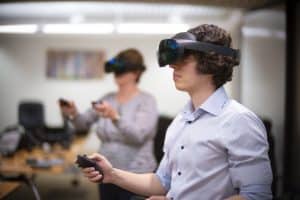
Research Scientist Dr. Ian Perera’s work at IHMC’s Ocala campus includes artificial intelligence, cognitive science and more.
Research Scientist Dr. Ian Perera led the coordination of the event along with Laurie Zink, development and community outreach director at the Ocala campus.
“(The showcase) created an opportunity to open up opportunities for collaboration with industry and researchers, engage with educators to help them better understand how to prepare their students for the rapid changes in technology their students will experience, and reach out to the public to show them the work we’re doing to augment their capabilities,” Perera said.
The hands-on demonstrations aimed to connect with different human capabilities – from physiological monitoring via eye tracking, to VR for identifying cognitive impairments from mild traumatic brain injury, to EEG for skill identification. Demos also included a memory augmentation app, work on enhancing the capabilities of Large Language Models, and identifying proficiency or potential talent for interacting with AI systems.
“Many visitors had never heard of IHMC and were amazed that we were engaged in such interesting work in their community,” Perera said. “Educators were very impressed with the potential of technology to provide more insight into the human condition.” Archna Bhatia received excited feedback from those who eagerly awaited the release of the memory augmentation app incorporating her research, with many saying they wanted to use it themselves or recommend it to family members.
Ocala hosts community outreach efforts including Evening Lectures, Science Saturdays and Summer Robotics Camp on campus. Laurie Zink, development and community outreach director in Ocala, said many showcase guests had never been to IHMC before and all left impressed.
“We gave out so much information on our education outreach opportunities and made and enhanced connections in the community that will be critical to our continued success,” Zink said. “We are looking forward to next year’s showcase already.”
Projects featured included:
- A cognitive assessment deployed in both virtual reality and an online platform, to aid in early detection of mild traumatic brain injury. These injuries can occur from sports impacts or near explosions or detonations in military situations and training and can have a significant impact on cognitive functioning — even without a clinically defined concussion happening.
- Hardware that allows eye tracking underwater to help track this crucial indicator for physiological state. In underwater situations, changes in an air mixture can rapidly affect an individual’s cognitive state, and early detection of this can save the lives of divers.
- Applying Large Language Models and Reinforcement Learning to teach LLMs to automatically learn to solve open-ended puzzle games, which is challenging at present for the models.
- A partnership with Army Research Laboratory to develop questionnaires and tasks that identify and stress the core cognitive skills needed to work with AI, which can often be opaque and unpredictable.
- A memory augmentation project focused on harnessing Natural Language Processing to help seniors with Alzheimer’s Disease and related dementias retrieve words in the course of daily life. The effort is being supported by funding from the Massachusetts AI and Technology Center, a member of the a2 Collective, which represents the Artificial Intelligence and Technology Collaboratories for Aging Research (AITC).
- A project using electroencephalography (EEG) to determine a person’s cognitive state (concentration, mood, fatigue, etc.), their reaction to stimuli, and their innate or learned skills in certain tasks.
- Work in the new Healthspan, Resilience, and Performance Research Center to better understand the factors that determine human health and abilities, and how we can build on that foundation toward optimizing the human experience.
IHMC is a not-for-profit research institute of the Florida University System where researchers pioneer science and technology aimed at leveraging and extending human capabilities. IHMC researchers and staff collaborate extensively with the government, industry and academia to help develop breakthrough technologies. IHMC research partners have included: DARPA, the National Science Foundation, NASA, Army, Navy, Air Force, National Institutes of Health, IBM, Microsoft, Honda, Boeing, Lockheed, and many others.
STEM-Talk wins Signal Award in Health & Wellness Podcasts
Published 10.30.24
IHMC’s podcast STEM-Talk has earned another accolade, winning the bronze award in the third Annual Signal Awards for best General Health and Wellness podcast.
Dr. Ken Ford, IHMC’s co-founder and CEO, co-hosts the podcast with colleagues from IHMC, including Drs. Dawn Kernagis, Marcas Bamman, and Tommy Wood. The episode featured by the Signal Award is Episode 162 with Dr. Marc Hamilton, an international expert in muscle physiology and professor at the University of Houston. He has published pioneering work on the soleus push-up, a potent physiological method which Marc discovered having the ability to elevate metabolism for hours, even while sitting.
STEM-Talk, with more than 170 episodes, features conversations with some of the most interesting people in the world of science and has been downloaded by more than 4.3 million people across the world since its launch in 2016.
In 2019 and 2017, STEM-Talk won first place in the Science and Medicine category of the annual People’s Choice Podcast Awards. In 2020, STEM-Talk was nominated for a Webby Award in Science and Education.
“The STEM-Talk team is honored by the recognition from the Signal Awards,” Ford said. “We began STEM-Talk to create a venue for thoughtful and insightful conversations with scientists, researchers, and experts of the highest caliber. Awards such as the Signal Award are a gratifying recognition of our efforts.”
The latest episode features Dr. Rudy Tanzi, best known for co-discovering all three familial early onset Alzheimer’s genes — discoveries that have expanded what we know about the disease, how we might counter its effects, and the speed with which drug therapies can be brought to market.
Tanzi has co-written two books with Deepak Chopra, “Super Brain” and “The Healing Self,” and is one of the top 50 most cited neuroscientists in the world. He also plays keyboards in the studio for Aerosmith and its guitar player Joe Perry.
Now in its third year, entrants to The Signal Awards are reviewed by The Signal Awards Judging Academy, an esteemed collective made up of the architects, instigators and trailblazers of the medium. Once a year, The Academy collectively listens closely to thousands of hours of audio, selecting the strongest work to be elevated to the status of award-winning.
“STEM-Talk made an impression on the judges,” said Jemma Brown, General Manager of The Signal Awards. “This award is a testament to the skill, ingenuity, and vision of its creators.”
Browse the STEM-Talk library today at https://www.ihmc.us/stemtalks/
The Signal Awards set a standard for editorial excellence by honoring the organizations, artists, mavericks and brands who are shaping the podcast industry, and the storytelling medium. Each year, The Signal Awards present Gold, Silver and Bronze Award Winners, and the listening public votes for their favorite Finalists to take home the additional honor of Listener’s Choice Award in each category.
IHMC is a not-for-profit research institute of the Florida University System where researchers pioneer science and technology aimed at leveraging and extending human capabilities. IHMC researchers and staff collaborate extensively with the government, industry and academia to help develop breakthrough technologies. IHMC research partners have included: DARPA, the National Science Foundation, NASA, Army, Navy, Air Force, National Institutes of Health, IBM, Microsoft, Honda, Boeing, Lockheed, and many others.


